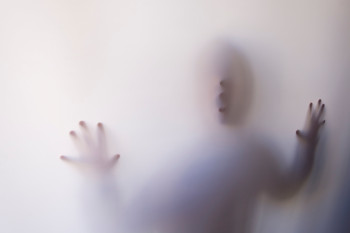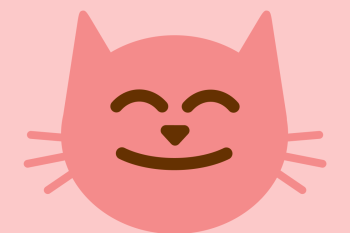© Pint of Science, 2024. All rights reserved.
The human mind – the basis of great scientific discoveries, and the source of our creativity and artistry at the same time. For Creative Reactions 2021, the following five psychologists paired up with five different artists to explore the way we think through SciArt.
Lina Vourlou and Joanne Eaves
Joanne Eaves studies why some children and adults find mathematics difficult. She says:
'I am looking at whether cognitive skills (e.g. memory, inhibition, switching) are important. More specifically, I am looking at the role of inhibition in multiplication fact learning. Inhibition is the ability to pause and stop before you act (i.e. withhold impulsive behaviour), and the ability to resolve conflicting information. We think inhibition might be involved in learning and retrieving answers to multiplication facts because of the way they are taught and learnt, in association with one another.'
She gives the following example:
'6 x 7 and 6 x 8 are both in the 6 times table, and therefore their answers (42 and 48) might be associated in memory. When people are asked to solve multiplication problems, the answer to the neighbouring problem might therefore interfere, which they need to overcome in order to produce the correct result. I'm currently investigating this suggestion through a series of online studies with adult participants, and in a year or so, through a learning study with individuals of different ages.'
Collaborating with Joanne, Lina Vourlou created ΕΠΙ (EPI), a video collage (above). She says:
'The work begins with a moving mesh cloud of a Greek multiplication equation. Following this, a brain starts forming, as an indication to the activity that goes on in the brain when taking maths in; the maths being taken in through the iris, which the video further evolves into. The sound included in the piece is a combination of various harmonic notes, and alpha waves, which have proven to improve concentration and memory. My whole aim for this project was to tell a visual story of the journey and process of absorbing mathematical information, with my own psychedelic twist.'
Find out more on Lina's website and on Lina's instagram.
Find Joanne on Joanne on Twitter.
Stephanie Mackenzie and Hannah Slack
Our brains of course do so much more than calculating mathematics. Hannah Slack looks at how people’s brains can tell the difference between an action that they have performed vs. an action that someone else has done. She describes her research focus:
'I look at how this ability develops as teenagers grow. I also investigate how this ability develops differently in teenagers with and without Tourette Syndrome. To do this, I create fun online games where players can battle against the computer in series of a car races or help an elite detective to hunt down a notorious jewel thief.'
She thoroughly enjoyed her Creative Reactions collaboration:
'It was evident from our first conversation that Stephanie is incredibly talented and has a deep passion for her work. We discussed the ways in which the brain’s initial hesitation in identifying an action as its own could be represented through different styles of paint brushstrokes. It was amazing seeing how my research could be brought to life through Stephanie’s art. I am fascinated by the way in which both viewing and creating art can improve an individual’s mental health and well-being. However, taking part in Creative Relations has opened my eyes to how art can be a powerful medium for sharing scientific discoveries with the world.'
Finally, Hannah shares this tip:
'If any of the artwork on display at the exhibition has peaked your interest, feel free to reach out to the scientists and artists behind the piece. They will often be more than happy to discuss their research or art with you in further detail. I also want to recommend to any scientist or artist who is thinking about being involved in Creative Relations to get involved!'
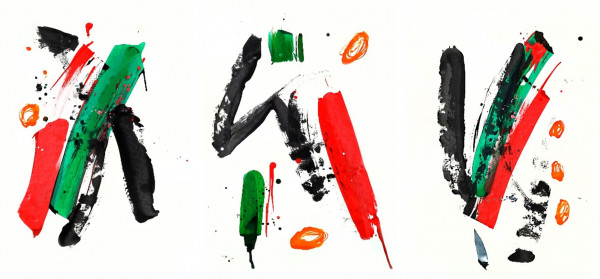
SENSE CONTROL - Trilogy A B C (series). Acrylic, Acrylic Ink on Archival Paper by Stephanie Mackenzie.
Artist Stephanie Mackenzie tried out Hannah’s online video game. She says:
'I let my inner feelings come out on the archival paper, illustrating what was seen and felt subconsciously. The bright colors represent traffic lights, roads and car tires. The form of shapes and texture represent what I visually recorded: a personal measurement between action and outcome. "Amber Light" gives its viewer the power to choose a reaction. Should you stop or should you go before red? You are the author of your movement. You control your own volitional actions. Moving your foot to gas or break. In this case, the "Space Bar" on the video game's keyboard. Brushstrokes, shape and form represent my action to move. To press the Space Bar is to move the vehicle on screen.'
Find out more on Stephanie's website, Stephanie's Instagram and Hannah's website.
Gabrielle Hoad and Rebecca Hock
Delving into the neuronal network, behavioural neuroscientist Rebecca Hock studies the physical and chemical components of our brains and how they allow us to think and behave.
'In our lab, we train rats to make associations between cues. We study how the brain learns to make associations between relevant events and, importantly, to learn when these events are no longer connected. Sometimes we may experience problems with learning to “disconnect” events that are no longer relevant, and to restrain thoughts or actions that are not appropriate to new situations. Such actions can include overeating, or other impulsive behaviours seen in addiction. People with anxiety or schizophrenia may also struggle to inhibit irrelevant associations. Preclinical research using animal models allows us to get a step closer to finding treatments for such conditions.'
Credits: Image of white rat adapted from original by Jean-Etienne Minh-Duy Poirrier under a Creative Commons licence CC BY-SA 2.0; Image of rat brain adapted from The SIGMA rat brain templates and atlases for multimodal MRI data analysis and visualization by D.A Barrière, R. Magalhães et al. Nature Communications Vol. 10, Article 5699 (2019) under a Creative Commons licence CC BY 4.0
Inspired by the use of animal models, Gabrielle Hoad says:
'Testing assumptions about the human brain using laboratory rats is common practice in medical research. It’s part of a wider interdependency between our two species.'
In her animation, she 'mingles images of human and rodent heads so that they are difficult to tell apart. A sense of malleability in the imagery points to the research team’s interest in inhibitory learning: how healthy brains are able to adapt and ‘apply the brakes’ to unhelpful reactions.'
She explains the title:
'In neuroscience, ‘crosstalk’ refers to the way that electrochemical signals in the brain may affect others. But there is also a sense in which crosstalk (ie incidental communication) between rats and their handlers is part of everyday life in the lab, and an acknowledgement of their agency outside the mechanics of experimentation.'
Find out more on Gabby's website, Gabby's Instagram and on Rebecca's Twitter.
Lynne Chapman and Jade Duffy
Chemicals, behaviour, learning – all these are part of what makes up our personality. Jade Duffy is interested in the Jungian perspective of personality. She sums up the theory:
'He suggested that we have multiple facets inside us that makes up an entire personality. For the basis of simplicity, the artwork only focuses on the three most discussed parts of personality – the ego, persona and shadow.
'The ego works as the structure of the personality, being the main characteristics that shine through in all situations.
'The shadow is considered to contain, what we or society, would consider to be undesirable traits and can also be associated with ‘evil’. This is not always the case, such as creativity being considered a chaotic trait, is not negative in the slightest. It is only when we lean into the shadow does it demonstrate the traits of a ‘bad’ person.
'Finally, there is the persona. The opposite of the shadow, it mainly contains the traits that we, or society, would consider to be desirable. This is then the mask people will usually present in situations where judgement might occur – such as the workplace or social situations. If this side of the personality is leant into then a person can lose reality of who they are and only care about the thoughts of others.
'Overall, when a person becomes aware of these components and allows them to equally interact, do they truly reach individuation – content in who you are.'
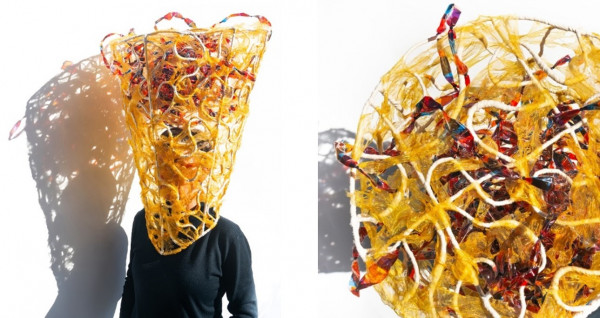
Individuation. A mixed media headdress by Lynne Chapman. Right: Close-up from the top
Artist Lynne Chapman created a headdress which expresses the relationships between Ego, Persona and Shadow. She explains:
'The Ego is represented by the main structure, a framework bound in white cotton, to suggest neutrality, which winds around the head in undulations inspired by the contours of the brain. Our Ego underpins everything: it is the framework that shapes the whole.
'The Persona - heat-treated, golden organza - weaves around the Ego, overlaying and almost obscuring it at times, presenting an embellished surface: the self we like to show to society.
'The Shadow is locked within the Ego, a whirling chaos of cellophane, representing those untamed, mostly darker traits we generally suppress. Periodically, the Shadow bursts through, sometimes by the design of the Ego, occasionally by accident.'
The headdress can be seen from all sides in this video:
Find out more Lynne's website, Lynne's second website and on Lynne's Instagram.
Rupinder Khaira and Shreyasi (Cece) Desai
One essential aspect of the human mind is that we are all different, and we all react differently to situations and experiences. Shreyasi (Cece) Desai researches how trauma has varied effects on us. She explains:
'We may use too many words or be unable to speak; have too many thoughts, or feel numb; cry constantly, or not at all.'
These reactions may be judged by others:
'In sexual crime cases, these effects of trauma, which should ideally have no bearing, often become deciding factors for the case outcomes. Instead of the perpetrator, the behaviour of the victim is judged.'
This underlines the need for further studies:
'My research investigates the factor of language, and whether the usage of exaggeration in victim testimony impacts how victims are perceived by professionals and laypersons. These perceptions subsequently impact whether a case is sent to trial, and whether justice is served.'
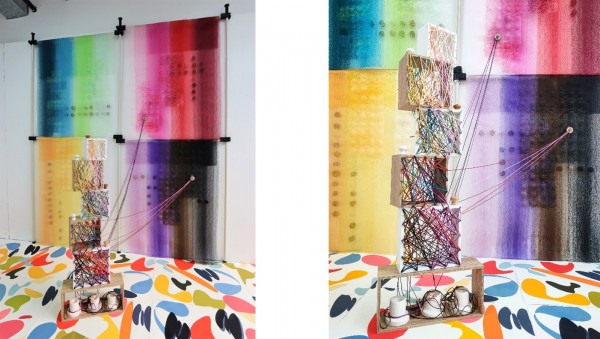
Untitled. Mixed material - found objects, web mesh, string & screen print, by Rupinder Khaira. Right: close-up.
Inspired by the themes of trauma, reaction and language, Rupinder Khaira explored the topic through art:
'This artwork is a representation of the interrelated dynamics of human interaction within an environment. Taking inspiration from Philosopher Gaston Bachelard’s book Poetics of space and the Buddhist perspective of Emptiness. The fabric represents the house of lived experience reflected in the imprints and door handles which are placed to indicate the paths we open through choice and consented actions.
'The art installation illustrates when this choice and consent is obstructed. The strings reveal new lines of feeling and emotion associated with past lived experiences. The work is also a reverence to hyperbole and labels; the strings stretching outwardly signify our relation to words, and how knowing what something means can impact our perspective and response to a situation.'
We hope you share our fascination for these different aspects and interpretations of the human mind! You can find these artworks and more in our virtual exhibition until the end of June 2021.
About this post
This blog post is a part of the Creative Reactions Pint of Science 2021 online exhibition. Throughout May and June, we will open the gallery for different examples of collaborations between art and science at creativereactions.com.

